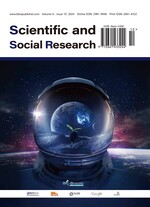Abstract
The development of sustainable packaging materials has been a major challenge in the packaging industry. The recyclability of nanocellulose plays an important role in promoting sustainability and the advancement of a circular economy through the provision of renewable and eco-friendly feedstocks as alternatives to traditional materials. This paper aims to highlight the challenges and opportunities presented by nanocellulose as a sustainable and multifunctional packaging material. In addition, this paper discusses the current state of the art of nano cellulose and nano inorganics as sustainable alternatives to synthetic plastics. The sustainability of packaging materials is an ineluctable challenge for the packaging industry, which should be developed within a circular economy, with minimum environmental impacts. In this context, nanocellulose remains one of the most promising derivatives from renewable resources because it shows excellent recyclability, biodegradability, and multi-functional properties. This review aims to point out different prospects of nanocellulose for being a bio-alternative to conventional packaging materials, hence examining challenges and opportunities regarding its application. The paper also discusses recent advances in the combination of nanocellulose with nano-inorganics as promising alternatives to synthetic plastics, providing an overview of its role in fostering sustainability in the packaging industry.
References
Ncube LK, Ude AU, Ogunmuyiwa EN, et al., 2020, Environmental Impact of Food Packaging Materials: A Review of Contemporary Development from Conventional Plastics to Polylactic Acid Based Materials. Materials, 13(21): 4994.
Jabeen N, Majid I, Nayik GA, 2015, Bioplastics and Food Packaging: A Review. Cogent Food & Agriculture, 1(1): 1117749.
Teixeira-Costa BE, Andrade CT, 2021, Natural Polymers used in Edible Food Packaging—History, Function and Application Trends as a Sustainable Alternative to Synthetic Plastic. Polysaccharides, 3(1): 32–58.
Bastioli C, 2001, Global Status of the Production of Biobased Packaging Materials. Starch-Starke, 53(8): 351–355.
Siracusa V, 2016, Packaging Material in the Food Industry, in Antimicrobial Food Packaging. Academic Press, Cambridge, 95–106.
Wani WA, Pathan S, Bose S, 2021, The Journey of Alternative and Sustainable Substitutes for “Single-Use” Plastics. Advanced Sustainable Systems, 5(12): 2100085.
Singh N, Ogunseitan OA, Wong MH, et al., 2022, Sustainable Materials Alternative to Petrochemical Plastics Pollution: A Review Analysis. Sustainable Horizons, 2022(2): 100016.
Epps III TH, Korley LT, Yan T, et al., 2021, Sustainability of Synthetic Plastics: Considerations in Materials Life-Cycle Management. Jacs Au, 2(1): 3–11.
Khandeparkar AS, Paul R, Sridhar A, et al., 2024, Eco-friendly Innovations in Food Packaging: A Sustainable Revolution. Sustainable Chemistry and Pharmacy, 2024(39): 101579.
Moustafa H, Youssef AM, Darwish NA, et al., 2019, Eco-friendly Polymer Composites for Green Packaging: Future Vision and Challenges. Composites Part B: Engineering, 2019(172): 16–25.
Ketelsen M, Janssen M, Hamm U, 2020, Consumers’ Response to Environmentally-friendly Food Packaging: A Systematic Review. Journal of Cleaner Production, 2020(254): 120123.
Hussain S, Akhter R, Maktedar SS, 2024, Advancements in Sustainable Food Packaging: From Eco-friendly Materials to Innovative Technologies. Sustainable Food Technology, 2(5): 1297–1364.
Ferrer A, Pal L, Hubbe M, 2017, Nanocellulose in Packaging: Advances in Barrier Layer Technologies. Industrial Crops and Products, 2017(95): 574–582.
Ahankari SS, Subhedar AR, Bhadauria, SS, et al., 2021, Nanocellulose in Food Packaging: A Review. Carbohydrate Polymers, 2021(255): 117479.
Li F, Mascheroni E, Piergiovanni L, 2015, The Potential of Nanocellulose in the Packaging Field: A Review. Packaging Technology and Science, 28(6): 475–508.
Wang J, Han X, Zhang C, et al., 2022, Source of Nanocellulose and its Application in Nanocomposite Packaging Material: A Review. Nanomaterials, 12(18): 3158.
Shanmugam K, Browne C, 2021, Nanocellulose and its Composite Films: Applications, Properties, Fabrication Methods, and their Limitations, in Nanoscale Processing. Elsevier, Amsterdam, 247–297.
Kargarzadeh H, Mariano M, Huang J, et al., 2017, Recent Developments on Nanocellulose Reinforced Polymer Nanocomposites: A Review. Polymer, 2017(132): 368–393.
Mishra S, Kharkar PS, Pethe AM, 2019, Biomass and Waste Materials as Potential Sources of Nanocrystalline Cellulose: Comparative Review of Preparation Methods (2016–Till date). Carbohydrate Polymers, 2019(207): 418-427.
Mateo S, Peinado S, Morillas-Gutierrez F, et al., 2021, Nanocellulose from Agricultural Wastes: Products and Applications—A Review. Processes, 9(9): 1594.
Dufresne A, 2019, Nanocellulose Processing Properties and Potential Applications. Current Forestry Reports, 2019(5): 76–89.
Yang Y, Boom R, Irion B, et al., 2012, Recycling of Composite Materials. Chemical Engineering and Processing: Process Intensification, 2012(51): 53–68.
Wang Q, Yao Q, Liu J, et al., 2019, Processing Nanocellulose to Bulk Materials: A Review. Cellulose, 2019(26): 7585–7617.
Azeredo HM, Rosa MF, Mattoso LHC, 2017, Nanocellulose in Bio-based Food Packaging Applications. Industrial Crops and Products, 2017(97): 664–671.
Du X, Zhang Z, Liu W, 2017, Nanocellulose-based Conductive Materials and their Emerging Applications in Energy Devices: A Review. Nano Energy, 2017(35): 299–320.
Jeet K, Kumar V, Anushree, et al., 2022, Valorization of Agricultural Wastes: A Step toward Adoption of Smart Green Materials with Additional Benefit of Circular Economy, in Handbook of Biomass Valorization for Industrial Applications. John Wiley & Sons, New Jersey, 343–367.
